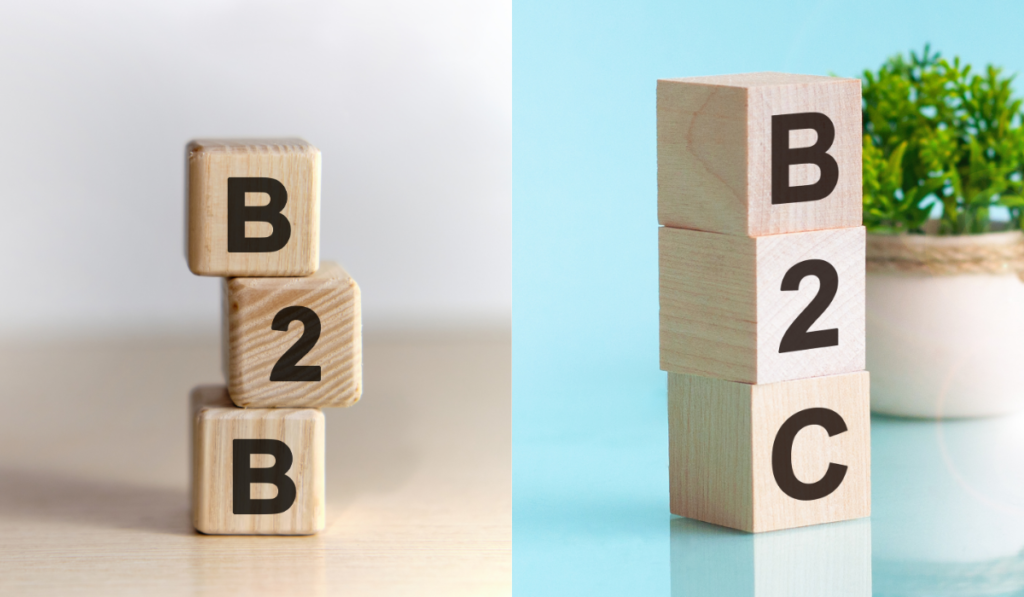Definition of B2B
The term “business-to-business” (B2B) describes exchanges between companies. This typically entails one company providing goods or services to another company.B2B virtual advertising works to create leads and cultivate long-term connections by focusing on organizational decision-makers. It’s by far the most typical kind of business, where companies offer goods or services to help other companies with their difficulties.Examples of both B2C and B2B content marketing could be:
Examples may include:
- A company that offers solutions to assist other organizations in inventory management.
- A consulting firm that helps various companies create and use marketing and advertising strategies.
- A supplier of corporate-focused cloud-based services for managing and storing records.
- A manufacturer who supplies bulk raw materials to various organizations so they can use them to make their goods.
Definition of B2C
Business-to-consumer (B2C) interactions are those in which companies immediately market goods or services to specific customers. B2C virtual marketing is to attract, engage, and convert those prospects into customers in order to increase revenue and foster brand loyalty.
Examples may include:
- A clothes retail store that provides accessories to individual customers right away.
- A grocery store that provides customers with food supplies immediately for their personal use.
- An employer that promptly markets and promises client electronics to individual customers.
- An online retailer where customers can purchase handcrafted goods.
Distinguishing between B2B and B2C
Content marketing is a powerful tool for engaging audiences, but the approach can differ significantly between Business-to-Business (B2B) and Business-to-Consumer (B2C) models.
Understanding these differences can help tailor your strategies to better meet the needs of your target audience.
Goal Groups
- B2B Marketing: Aimed at businesses, organizations, and experts. Decision-makers like managers, CEOs, and buying departments are the main focus.
- B2C Marketing: B2C marketing: Focuses on specific customers. Appealing to the individual needs, feelings, and preferences of the audience is the main goal.
Local versus global marketing
- B2B: Companies catering to foreign markets may employ global marketing methods more frequently. Localization could concentrate on modifying communications to fit certain corporate procedures or industry rules.
- B2C: Local marketing is crucial, particularly for service and retail businesses. Localization entails modifying offerings, campaigns, and content to suit local tastes, customs, and languages.
Pricing Method
- B2B: With contracts, bulk pricing choices, and discussions, pricing is frequently more complicated. Return on investment (ROI) and value are prioritized.
- B2C: In order to attract customers, pricing is usually simple, affected by rivals, and may include special offers, deals, and promotions.
Brand Adherence
- B2B: Trust, enduring connections, and the steady provision of value are frequently the foundations of brand loyalty. Loyalty programs are less prevalent but place a greater emphasis on account maintenance and customer pleasure because switching might be costly.
- B2C: Brand affinity, emotional ties, and customer experience are the main drivers of brand loyalty. Personalized experiences, discounts, and loyalty programs are popular methods for keeping customers.
Seasonality
- B2B: Well depending on the industry, seasonality may have an effect on B2B marketing. Marketing operations may be affected by a number of factors including, but not limited to, fiscal year-end cut off dates, schedule of trade shows and budgeting cycles. However, in most cases and compared to B2C, B2B marketing practice tends to be seasonal and less so.
- B2C: Seasonality is of significance; marketing strategies and tactics usually revolve around certain periods, events or trends. For businesses peak season for purchasing could be black Friday, holiday seasons or favorable back-to-school sales.
Internal Buy-in
- B2B: Marketing strategies most of the time call for buy-in from the internal company of which the sales department, the product one and/or the customer support division are the most likely. Coordination within the organization is very important in the implementation of such programs.
- B2C: Internal buy-in is still important but may be more focused on bringing together marketing with branding customers and sales. Internal focus accountability in terms of carrying different message angles to customers at different times is also an important one.
Customer Segmentation
- B2B: Segmentation is usually practiced around firmographic data variables including: size of the firm, which industry, revenue size, customer requirements or buying patterns. Segments are assumed in terms of size as smaller, like smaller as precise.
- B2C: Segmentation approaches include targeting groups defined by demographics psychographics, behaviors and even parts of geography. Segments are also wider than a singular group understanding the lifestyles, attitudes and preferences of consumers
Data Privacy and Security
- B2B: Data privacy and security are critical, especially when dealing with sensitive business information, proprietary data, or compliance with regulations like GDPR or HIPAA. Trust in data handling practices can be a dealbreaker.
- B2C: While still important, data privacy concerns are more about protecting personal information, preventing identity theft, and ensuring secure transactions. Transparency in data usage is crucial for building trust with consumers.
Social Responsibility
- B2B: Ethical behavior, environmental effects, and industry norms are frequently linked to corporate social responsibility (CSR). In markets where reputation and trust are crucial, it can be a significant differentiation.
- B2C: Customers are expecting brands to take stances on social, environmental, and ethical concerns, making social responsibility more and more significant. Customer loyalty and brand perception may be impacted by this.
Cost of Customer Acquisition (CAC)
- B2B: Because of the lengthier sales cycles, more individualized marketing, and requirement for several touchpoints, the CAC is usually greater. Nonetheless, the expenditure is frequently justified by the increased client lifetime value.
- B2C: The cost-per-acquisition (CAC) is typically lower, but the emphasis is on volume, necessitating the use of effective and economical marketing techniques to bring in a sizable client base.
Market Research
- B2B: Industry trends, competitor analysis, and comprehending the particular requirements of a specialized audience are frequently the main focuses of market research. It entails thorough reports, polls, and interviews with important stakeholders.
- B2C: To better understand trends, preferences, and brand perception, market research is more comprehensive and frequently uses consumer surveys, focus groups, and social listening.
In summary
Though they require different approaches to successfully reach and engage their respective audiences, both B2B and B2C content marketing play critical roles in accomplishing business objectives. Marketers may provide more specialized, successful content that fits the requirements and tastes of their target audience by being aware of these variations.

